The Charm of Conveyer Belt Sushi
ERNEST YEN explores the history of Conveyor-Belt Sushi, and how it has become a firm favourite in our increasingly varied food culture.
BY
Ernest Yen
Social Media Manager
Hype Issue #57
Published on
August 21, 2023
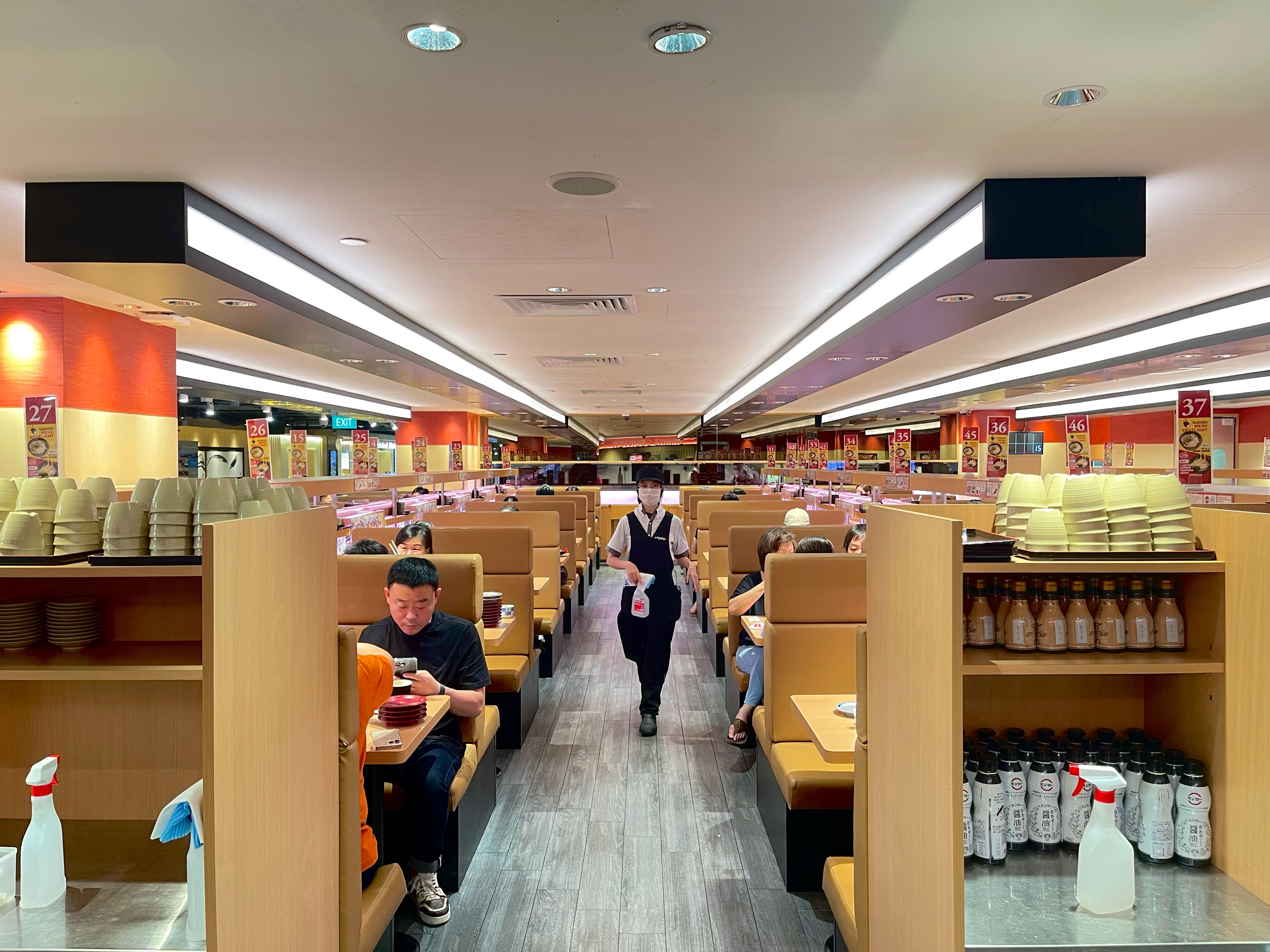
Sushiro is one of the most popular Conveyor Belt Sushi Chains in Singapore. Photo by Ernest Yen.
Step inside any shopping mall in Singapore, and it’s highly likely that you’ll come across a brightly lit store with a conveyor belt full of different plates of sushi revolving around the restaurant.
Welcome to Kaiten-Zushi, also known as Conveyor Belt Sushi in English. Here, a continuous stream of sushi plates gracefully travels around the restaurant on a conveyor belt, offering you the freedom to choose and savour any plate of sushi that appeals to your eyes.
Due to its affordability and diverse sushi selection, “Kaiten-Zushi” has gained popularity in Singapore, attracting customers young and old who frequently line up at well-known chains such as Genki Sushi and Sushiro. From Sashimi to Aburi-style, there’s always a sushi option to suit everyone’s taste.
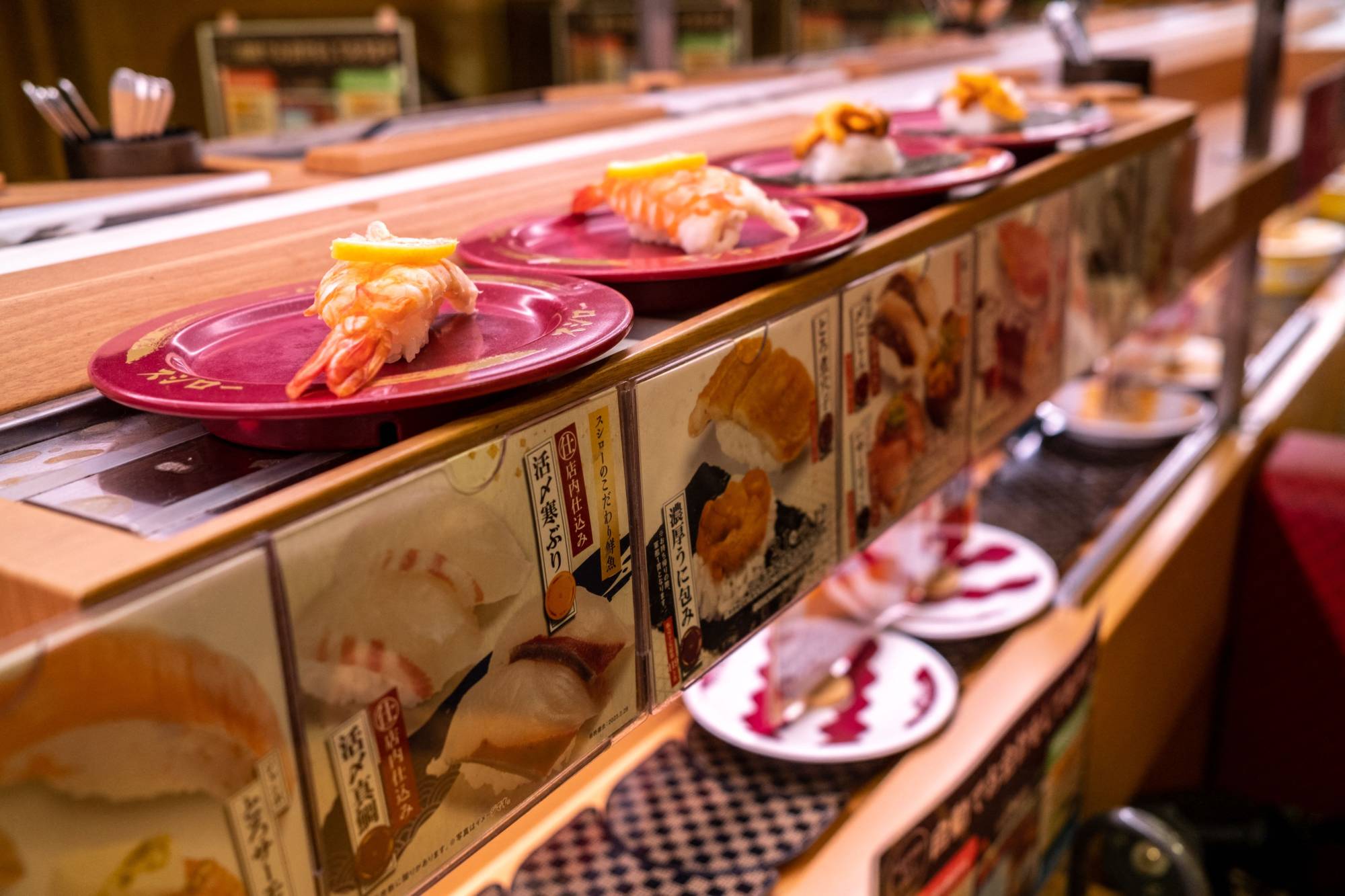
An example of sushi on a conveyor belt system at Sushiro. Photo Credit: The Japan Times
Nakeisha Lye, an 18-year-old who frequents Sushiro Singapore, says that“the variety of sushi (moving by) is what makes it interesting. It gives you a sort of tingling anticipation to grab the ones you want before they are taken by others.”
She finds the sight of different sushi passing by on the conveyor belt thrilling, and she feels compelled to try different varieties of sushi because seeing the dishes up close in real life is more appealing than just looking at menu pictures.
Sushi has historically been an expensive treat in Japan. It was only when conveyor-belt sushi was invented that it became a truly affordable and convenient meal for the masses.
The question is, how did this charming concept come about?
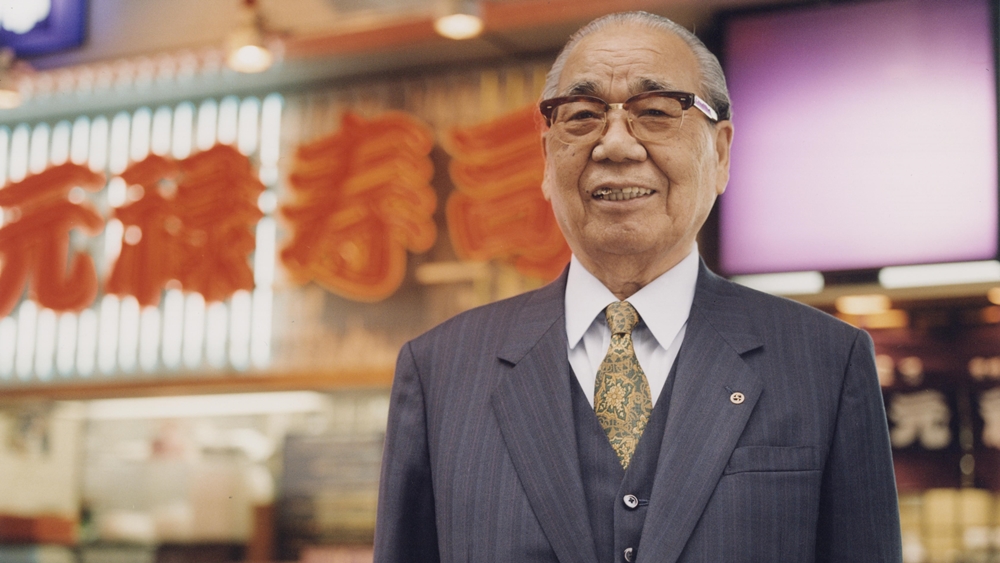
Yoshiaki Shiraishi, the creator of “Kaiten-Zushi”, commonly known as conveyor belt sushi. Photo Credit: @JapanGov on Twitter.
“Kaiten-zushi”, which directly translates to “rotating sushi”, was the brainchild of Yoshiaki Shiraishi (1914-2001). According to the Discoverist, he was managing a small sushi restaurant in Osaka all by himself and wanted to find an easier way to serve his sushi. In 1947, a surprising source of inspiration emerged for Shirashi when he visited an Asahi Beer Brewery. Watching the seamless movement of bottles on the factory’s conveyor belts sparked an inspiration within him, prompting him to spring into action.
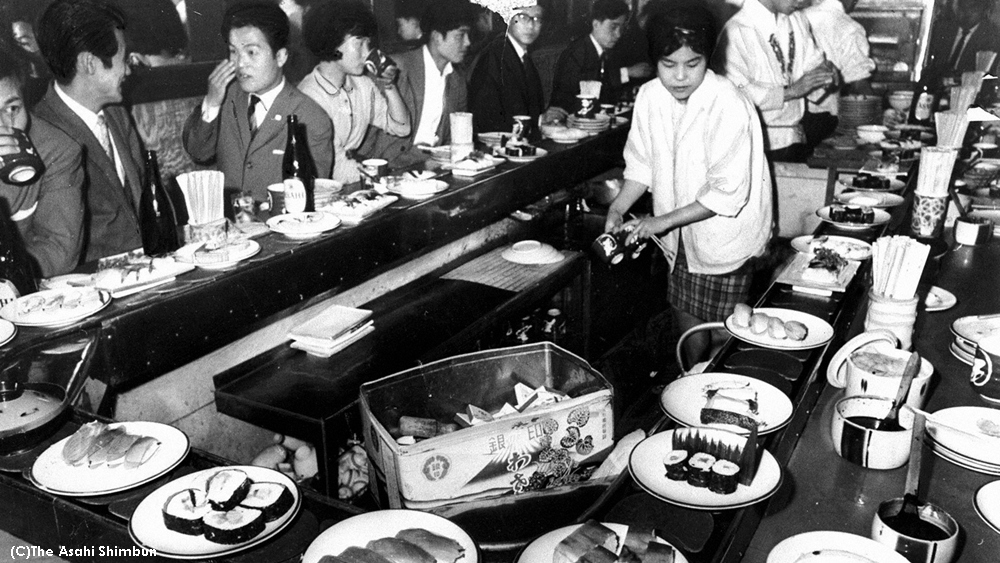
Mawaru Genroku when it first opened in East Osaka back in 1958. Photo Credit: @JapanGov on Twitter
Teaming up with a machinist, Shiraishi adopted this innovative concept and opened his first “Kaiten-zushi” restaurant, Mawaru Genroku in 1958, and the rest is history.
Jefferson, 39, an Assistant Manager at Sushiro Singapore mentioned that Singapore’s fast-paced lifestyle and desire for affordable yet high-quality meals have played a significant role in the popularity of conveyor belt sushi
“It also helps that our menu is not stagnant, as we make an effort to bring what the customers want and constantly add new dishes and sushi for our customers each month,” he added.
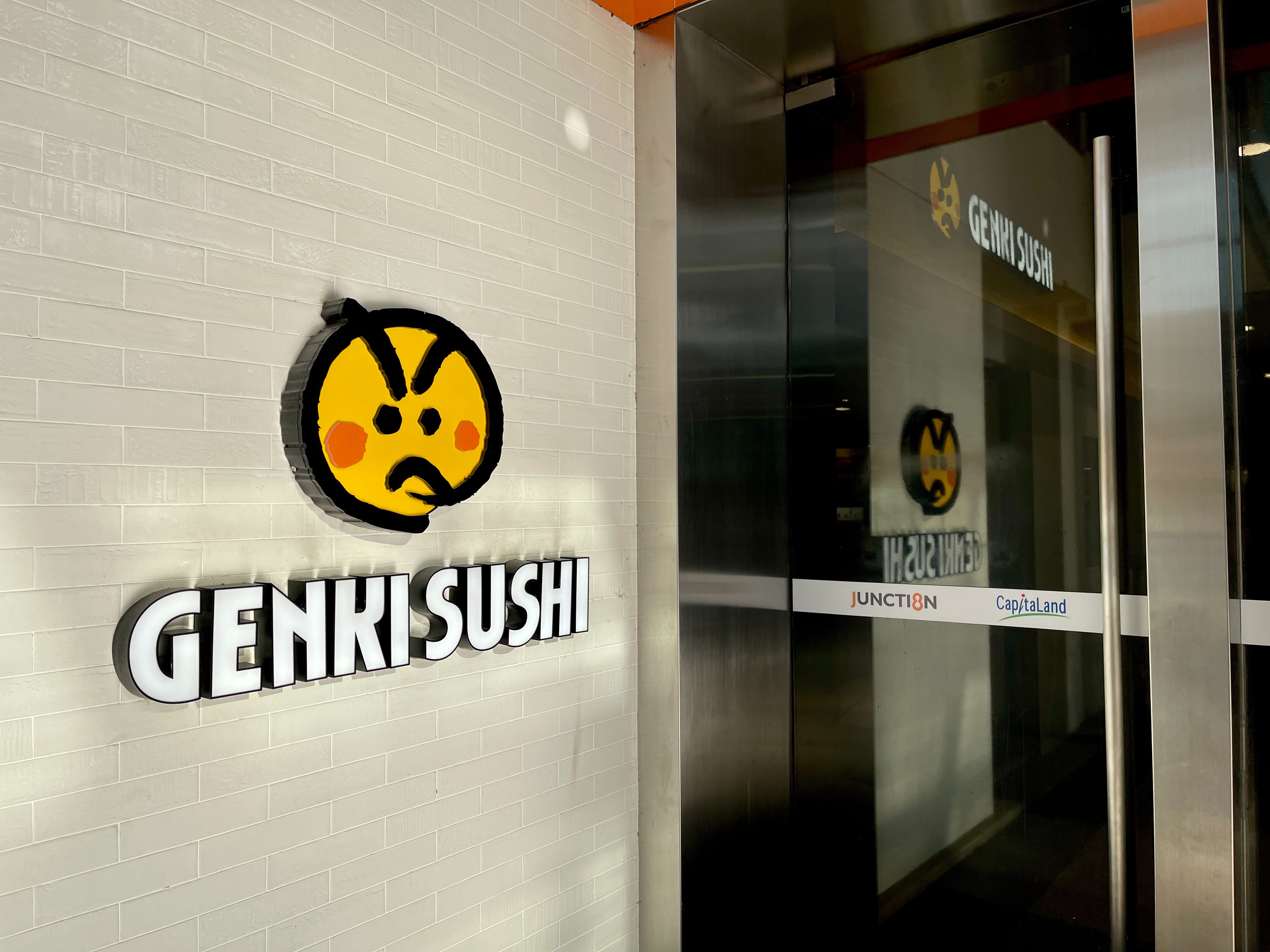
Genki Sushi outlet at Bishan Junction 8. Photo by Ernest Yen.
Genki Sushi has surprisingly been a leader in Singapore’s Conveyor-Belt Sushi scene for longer than expected.
A study published by the New Zealand Journal of Asian Studies in 2001 revealed that sushi had been present in Singapore since the early 1960s due to the influx of Japanese expatriates and that Genki Sushi actually entered the Singapore market back in 1993. There was even an outlet at Changi Airport back then!
Daniel Goh, 26, fondly recalls how Genki Sushi ignited his passion for sushi when he was a kid. “Truth be told, I never really ate sushi before until Genki first opened at Bugis all these years ago,” he said.
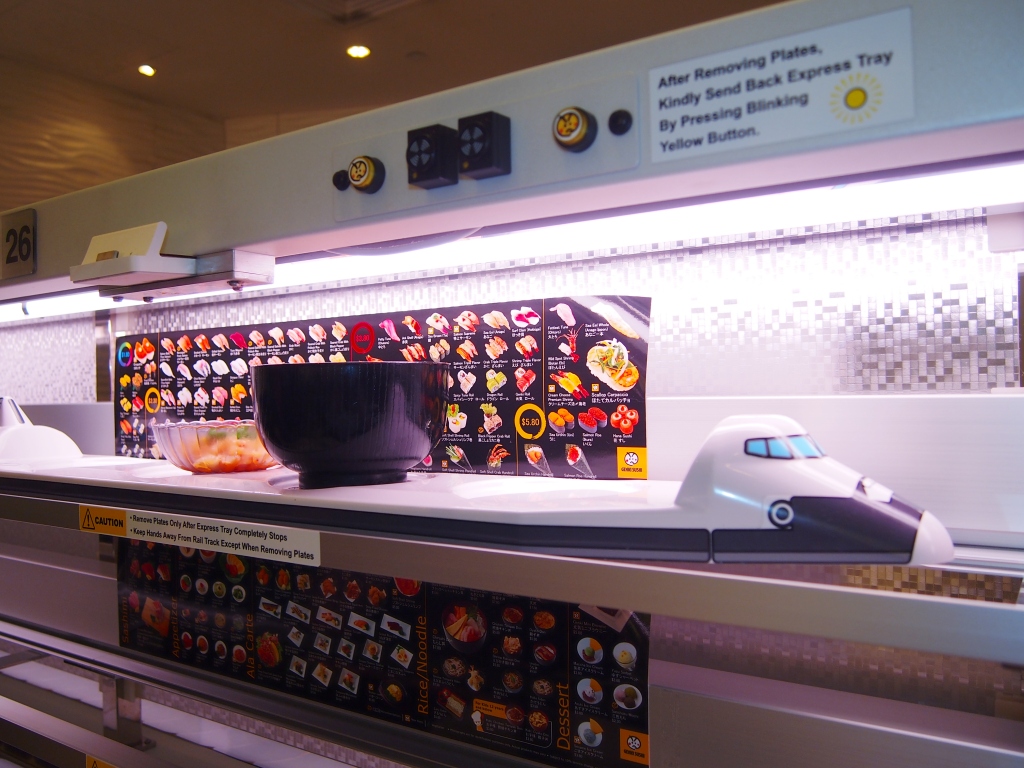
Genki Sushi’s unique conveyor belt delivery system, with trays shaped like Shinkansen, a high-speed train from Japan. Photo Courtesy of Thoughts on Air.
He added that their unique conveyor belt delivery system, with trays shaped like the iconic Shinkansen high-speed train from Japan, added an element of fun and novelty to the dining experience, which appealed to the younger him.
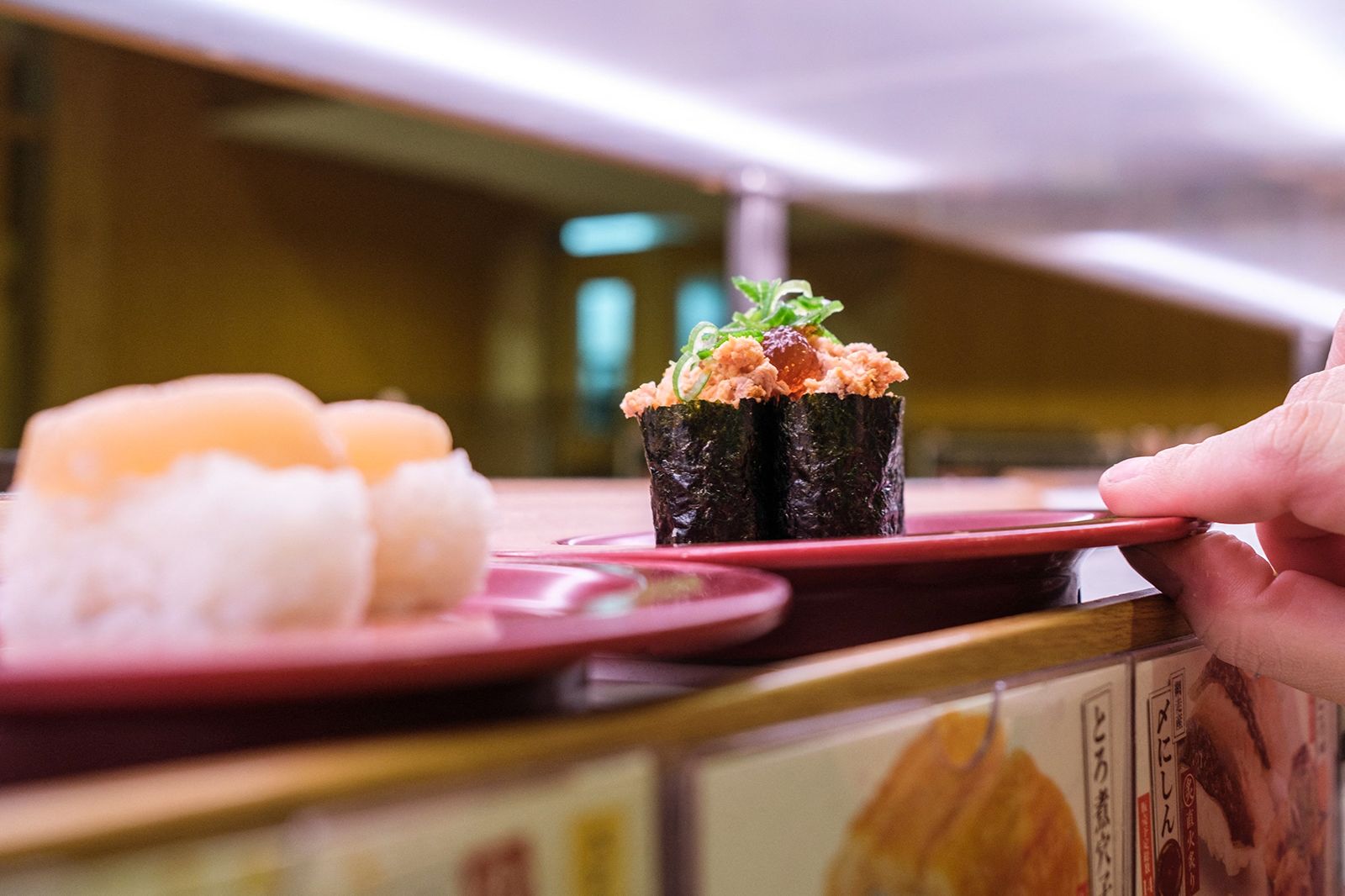
Sushiro uses an automated system to detect sushi plates on the conveyor belt. After traveling for 350m on the conveyor belt, the plates will then be automatically discarded to preserve sushi freshness for customers. Photo Credit: The Cable News Network (CNN).
However, a significant challenge faced by these restaurants these days is the mishandling of sushi plates by customers.
Jefferson explained that they frequently observe individuals and families touching or picking up plates of sushi from the conveyor belt, but instead of consuming them, they return the plates back to the belt.
“It’s obvious as we are the ones arranging the plates on the belt,” he pointed out.
Unfortunately, there is no concrete way to tackle this behaviour. “It’s frustrating, but at the end of the day, we can only explain to the customers nicely and return the sushi to them or just discard it entirely,” he said.
Despite the occasional challenges, “Kaiten-zushi ” has become an integral part of Singapore’s culinary scene.
“Since it’s so affordable, you might as well try everything! Get one of every dish, and you might find some gems!” Daniel said.
Likewise, Nakeisha said, “Give conveyor belt sushi a shot! If you haven’t tried it, you’re missing out if you don’t.”

Malatya Karacalar Ticaret | Fatih KARACA Malatya Stihl Bayi, stihl malatya bayi, stihlmalatya,malatyastihl, stihl servisi, malatya stihl servis, malatya testere,malatyastihlbayi, stihl malatya, malatya stihl, stihl bayisi malatya, Hekimhan stihl bayi, malatya testere bayisi, malatya stihl servis, stihl malatya servis, Malatya’nın en köklü Stihl bayilerinden olan Fatih Karaca Ticaret mağazamız, hem stihl satışı hem de stihl servisliğini yapmaktadır.
Einige Kunden finden, dass die Mcdonald’s Speisekarte Preise in den letzten Jahren gestiegen sind, was möglicherweise auf steigende Betriebskosten zurückzuführen ist.
Kes – Mak Bahçe Aksesuarları ve Yedek Parça | Malatya kesmak, kes-mak malatya, malatya kes-mak, motorlu testere yedek parça,Malatya Stihl Bayi, benzinli testere yedek parça, testere zinciri, ağaç kesme pala, klavuz, elektronik bobin, hava filtresi, stihl malatya bayi, stihlmalatya,malatyastihl, stihl servisi, malatya stihl servis, malatya testere,malatyastihlbayi, stihl malatya, malatya stihl, stihl bayisi malatya, Hekimhan stihl bayi, malatya testere bayisi, malatya stihl servis, stihl malatya servis,
Makaleniz açıklayıcı yararlı anlaşılır olmuş ellerinize sağlık
Malatya Karaca Ticaret | NURKAN KARACA Malatya stihl bayi,Malatya stihl servis,Hızar motoru,Motorlu testere,Motorlu tırpan, Çim biçme makinası,Malatya karacalar,Malatya stihl, nurkan karaca Malatya’nın en köklü Stihl bayilerinden olan Nazım Karaca ve torunu Nurkan Karaca şimdi e-ticaret platformlarında faaliyet yürütmektedir. Mağazamız, hem stihl satışı hem de stihl servisliğini yapmaktadır.
Kes – Mak Bahçe Aksesuarları ve Yedek Parça | Malatya kesmak, kes-mak malatya, malatya kes-mak, motorlu testere yedek parça,Malatya Stihl Bayi, benzinli testere yedek parça, testere zinciri, ağaç kesme pala, klavuz, elektronik bobin, hava filtresi, stihl malatya bayi, stihlmalatya,malatyastihl, stihl servisi, malatya stihl servis, malatya testere,malatyastihlbayi, stihl malatya, malatya stihl, stihl bayisi malatya, Hekimhan stihl bayi, malatya testere bayisi, malatya stihl servis, stihl malatya servis,
Lenipa Toptan Cep Aksesuarı telefon aksesuarları,telefon aksesuar toptan,telefon aksesuarlari toptan,toptan telefon aksesuar,toptan telefon aksesuarlari,cep tel,cep telefon,cep telefonu,en ucuz telefon,iphone 13 kılıf,iphone 13 pro kılıf,iphone 13 pro kılıfları,iphone 13 pro max kılıfları,iphone 13 pro max kılıfı,iphone kılıfları,telefon aksesuarları,telefon kılıfları,ucuz telefon,en ucuz akıllı telefon,en ucuz cep tel,en ucuz cep telefonu,en ucuz iphone 13,iphone 13 aksesuar,iphone 13 telefon kılıfları,iphone 13 şarj aleti,telefon ekran koruyucu,telefonlar ucuz,toptan telefon kılıf,ucuz akıllı telefon,ucuz cep tel,ucuz cep telefonu,ucuz telefon modelleri,şarj kılıfları,13 pro kılıfları,13 pro max en ucuz,akıllı cep telefonu en ucuz,akıllı telefon en ucuz,akıllı telefon kılıf,akıllı telefon ucuz,cep aksesuar,cep iletişim,cep tel en ucuz,cep tel kulaklık,cep telefon aksesuar,cep telefon ekran koruyucu,cep telefon ucuz,cep telefonu aksesuar toptan,cep telefonu aksesuarları,en ucuz 13 pro max,en ucuz akıllı cep telefonları,en ucuz iphone 13 pro,en ucuz iphone 13 pro max,en ucuz iphone telefon,en ucuz telefon modeli,en ucuz telefonlar iphone
Malatya Karacalar Ticaret | Fatih KARACA Malatya Stihl Bayi, stihl malatya bayi, stihlmalatya,malatyastihl, stihl servisi, malatya stihl servis, malatya testere,malatyastihlbayi, stihl malatya, malatya stihl, stihl bayisi malatya, Hekimhan stihl bayi, malatya testere bayisi, malatya stihl servis, stihl malatya servis, Malatya’nın en köklü Stihl bayilerinden olan Fatih Karaca Ticaret mağazamız, hem stihl satışı hem de stihl servisliğini yapmaktadır.
I’ve perused a number of exceptional articles on this site. It’s definitely worth saving for future visits. I’m curious about the tremendous effort you’ve invested in crafting such an informative and outstanding website. I’ll certainly be returning. By the way I am a Senior Researcher at Clickmen™ Social, a Social Media Marketing (SMM) Platform providing services throughout European Union, United States & Canada.
I loved as much as you will receive carried out right here. The sketch is tasteful, your authored subject matter stylish. Nonetheless, you command get an edginess that you’ll be delivering the following. I’ll unquestionably come further formerly again as it’s exactly the same nearly very often inside case you shield this hike.
God, you’re incredible! I can’t recall ever reading anything like it. What a relief to discover someone who has fresh ideas about this. Your initiative in launching this is truly appreciated. Someone with some creativity is really required on the web, and this website provides that.
Not only are you a very accomplished blogger, but this is also really interesting. I have subscribed to your feed, and I very much look forward to reading more of the excellent stuff that you produce. To add insult to injury, I have shared your webpage across all of my social media platforms!
relaxing
Nice post. I learn something totally new and challenging on websites
Hi there to all, for the reason that I am genuinely keen of reading this website’s post to be updated on a regular basis. It carries pleasant stuff.
Willkommen bei McDonald’s Speisekarte in Deutschland, wo das reichhaltige und vielfältige Menü eine köstliche Palette an Optionen für jeden Geschmack bietet. Beginnen Sie Ihren Tag mit unserem beliebten Frühstücksmenü, das eine breite Auswahl an leckeren Optionen für einen perfekten Start in den Morgen bietet. Von herzhaften Ei McMuffins bis hin zu süßen Pfannkuchen – unser Frühstücksangebot wird Ihren Gaumen verwöhnen. https://mcdonaldspeisekarte.de/
McDonald’s Singapore caters to local preferences with unique menu items like the Spicy McDeluxe and Bandung McFlurry. They also boast halal certifications at many outlets, ensuring inclusivity for the Muslim community. McDelivery, their 24/7 delivery service, caters to late-night cravings and busy lifestyles.
Flexible Conduit Pipes in Iraq ElitePipe Factory’s Flexible Conduit Pipes are a testament to our dedication to superior quality and dependability. These conduits are engineered to offer unmatched flexibility and durability, making them perfect for various applications, including electrical installations and protective covering for cables. Our Flexible Conduit Pipes are crafted to withstand harsh conditions while providing ease of installation and long-term performance. As a leading name in Iraq’s manufacturing sector, ElitePipe Factory ensures that our products meet the highest standards. Explore more about our Flexible Conduit Pipes at elitepipeiraq.com and experience why we are considered one of the most reliable providers in the region. elitepipeiraq.com.
First Watch is a Famous breakfast, brunch, and lunch restaurant known for its fresh ingredients and creative dishes. If you like to start your day with breakfast or enjoy a light and healthy lunch, the First Watch Menu has something for everyone.
First Watch is a popular spot for breakfast, brunch, and lunch, celebrated for its fresh ingredients and innovative dishes. Whether you’re looking to kickstart your day with a hearty breakfast or enjoy a light, healthy lunch, the First Watch menu has a wide variety of options to satisfy every palate.
The Cheesecake Factory is known for its extensive and diverse menu, offering something for everyone. From hearty American classics and flavorful international dishes to fresh salads, pastas, steaks, and seafood, the variety is impressive. Signature items include the Chicken Madeira, Avocado Egg Rolls, and of course, their legendary cheesecakes—available in over 30 decadent flavors like Original, Fresh Strawberry, and Oreo Dream Extreme. Whether you’re looking for a casual lunch, a family dinner, or just dessert, The Cheesecake Factory’s menu has options for every craving.
O Smart Play é um aplicativo de streaming de filmes gratuito muito popular no Brasil. Ele oferece os filmes e séries de TV mais recentes em qualidade HD. O apk do Smart Play é compatível com smartphones Android, TVs Android, Smart TVs e computadores. O Smart Play TV apk é um aplicativo de entretenimento que fornece conteúdo multimídia, como filmes, programas de TV, músicas e jogos. As Smart Play TVs são populares entre as pessoas devido à sua conveniência e às várias opções de entretenimento.
Los juegos de fútbol se han popularizado en los últimos años. La Adrenalina Gol es una popular aplicación de streaming de deportes en vivo que le permite experimentar el apasionante mundo de los partidos de fútbol / fútbol en vivo con Adrenalina Gol. Proporciona acceso a canales de TV en directo en Android, Windows y Android. Tanto si eres un jugador experimentado como si acabas de empezar, esta guía te explicará todo lo que necesitas saber sobre Adrenalina Gol y por qué destaca en los juegos de fútbol para móviles.
For anyone interested in trying out authentic Filipino party platters and classic favorites, check out the Amber menu in the Philippines. With a variety of options, from pancit to pichi-pichi and delicious barbecue, Amber offers a selection perfect for any occasion. You can view their full menu and place an order directly through their official site here.
Fluff Stack Suntec is renowned for its signature soufflé pancakes, which are light, airy, and visually stunning.
CapCut new version mod apk adds cutting-edge filters and effects. From cinematic overlays to trending TikTok transitions, users can effortlessly add visual flair to their clips, making them stand out on social media platforms or personal projects. Source: https://freeblueapp.com/capcut-old-version/
Costco Food Court’s hot dogs are legendary for a reason, they’re the ultimate combination of quality, flavor, and unbeatable value. Served with a soft, fresh bun, these oversized beef hot dogs are juicy, flavorful, and cooked to perfection. The best part? They come with a free soda, all for a price that’s been famously unchanged for years! Whether you’re a fan of piling on the condiments or enjoying it plain, Costco’s hot dog is a timeless classic that delivers every time. It’s the kind of satisfying treat that makes a trip to Costco even more memorable!
First Watch Menu is focused on nutritious and wholesome options that cater to health-conscious customers.
Lulubox APK Pro is compatible with Android devices and supports a wide range of games. It is frequently updated to include new features and games. https://lbproapk.com/
Canvas tarps are heavy-duty protective covers made from tightly woven cotton or polyester fabric. Known for their durability and versatility, these tarps are widely used in industries such as construction, agriculture, and transportation. Unlike synthetic tarps, canvas tarps offer breathability and reduce condensation, making them ideal for specific applications.
ViMusic emphasizes user control, offering extensive customization options. From theme selection to playback settings, users can tailor their experience to suit individual preferences. The app’s flexibility sets it apart from commercial alternatives, creating a truly personalized music environment.
“Kaiten-Zushi,” has become a staple in Singapore, offering affordable, diverse sushi options. Pioneered in Japan by Yoshiaki Shiraishi in 1958, it gained popularity worldwide for its convenience and novelty. Chains like Jollibee menu Sushiro and Genki Sushi continue to attract customers with fresh sushi and creative delivery systems, despite challenges like plate mishandling. It’s a must-try for sushi lovers!
The Kaiten-Zushi experience, where a conveyor belt delivers an affordable and diverse selection of sushi, closely parallels the Costco Food Court model. Just as conveyor belt sushi revolutionized accessibility to high-quality Japanese cuisine, Costco’s food court menu has transformed the way shoppers enjoy quick, delicious, and budget-friendly meals. At Costco Menu, I focus on bringing the same sense of excitement and value—whether it’s the iconic $1.50 hot dog combo or the rotating seasonal specials that keep customers coming back. Both experiences cater to fast-paced lifestyles, offering quality, variety, and affordability, making them irresistible to food lovers of all kinds!
MovieBox Pro is a popular streaming application that allows users to watch movies and TV shows with ease. Known for its modern interface, fast streaming, and high-quality videos, it has gained popularity worldwide. The app offers thousands of movies and shows across various categories, with the option to download content for offline viewing. With frequent updates and a vast content library, MovieBox Pro is an excellent choice for entertainment lovers.
First Watch has a fantastic menu with so many delicious choices. I love their lemon ricotta pancakes and farmhouse skillet! The prices are a bit higher than a typical breakfast place, but the food is fresh and well-prepared. If you’re looking for a quality brunch, it’s totally worth it
no doubt, it’s a well structured and well maintained restaurant in Singapore. But, if you want to visit this kind of Restaurant in Philippines visit “https://ambermenu.ph/locations”
Conveyor belt sushi is such a fun and convenient way to enjoy a variety of sushi! 🍣🚄 The mix of affordability, novelty, download minecraft apk and fresh options makes it a great dining experience.
Sushiro truly captures the essence of fun, fast, and fresh dining. The whole conveyor belt sushi concept adds a playful yet efficient vibe to the experience—perfect for Singapore’s fast-paced lifestyle. It’s fascinating how different industries adopt innovation to improve user experience. Similarly, with growing interest in clean energy, staying informed about options like solar panel price Pakistan is becoming just as relevant for smart living.
The concept of conveyor belt sushi is really fascinating—it’s amazing how it has become such a popular and fun dining experience in Singapore. With so many options moving by, it adds excitement to the meal. On another note, it’s also becoming common for people to buy viagra 100mg online for ease and privacy, which shows how much convenience matters today.
La historia y popularidad del Kaiten-Zushi en Singapur es realmente fascinante. Es increíble cómo una idea inspirada en una fábrica de cerveza terminó revolucionando la manera en que disfrutamos el sushi hoy en día. La combinación de accesibilidad, variedad y rapidez hace que este estilo de restaurante sea perfecto para la vida moderna. Además, la experiencia de ver los platos pasar en la cinta transportadora agrega un toque de emoción y anticipación. Por cierto, así como en la cocina es importante la precisión en las porciones, en otros aspectos de la vida también lo es, y para ello una calculadora de division puede ser una herramienta muy útil. ¡Definitivamente tengo que probar esta experiencia la próxima vez que visite Singapur!
This was such a fascinating read! I’ve always loved the concept of conveyor belt sushi, and learning about its origin from Yoshiaki Shiraishi makes it even more special. Sushiro and Genki Sushi have truly elevated the experience in Singapore, making quality sushi accessible and fun. The idea of grabbing a plate as it passes by really adds excitement to the meal — it’s almost nostalgic, kind of like how people feel about using the old version of Instagram, when everything felt more simple and personal. Thanks for sharing such a detailed and engaging piece!
Conveyor belt sushi is such a smart and fun way to enjoy fresh food, and it’s amazing how it’s become a part of everyday dining in Singapore. The history behind it and how it evolved over the years is just as fascinating as the experience itself. It’s great to see how places like Sushiro are keeping the concept alive with innovation and quality. If you’re into thoughtful stories and reflections like these Visite Site
FM WhatsApp is a modified version of the official WhatsApp that offers extra features like enhanced privacy, customization options, and media sharing beyond WhatsApp’s standard limits.
GBWhatsApp offers enhanced features like customization and privacy options that the official app doesn’t provide, ensuring better control.
People turn vegan for health reasons, with benefits like lowered blood sugar and reduced heart disease risk. Ethical vegans take it further, avoiding animal products in all aspects of life, from food to clothing and entertainment.https://restaurantmenupricesinusa.blogspot.com
Looking for more features than the official WhatsApp? GB WhatsApp is a powerful mod that lets you customize your chat experience, hide online status, send large files, and much more!
✅ Extra Privacy Options
✅ Theme Customization
✅ Media Download Without Limits
✅ Dual WhatsApp Support
Impressive Thanks for sharing Explore GBWhatsapp 2025
Message scheduling is another underrated gem in GB WhatsApp APK. You can set messages to send at a specific time—even if you’re not online. It’s great for birthday wishes, reminders, or follow-ups.
Discover a <a href=”https://www.youstable.com/dedicated-server-india”>cheap dedicated server in India</a> with high-performance hardware, 99.9% uptime, and 24/7 technical support. Ideal for businesses needing robust hosting for websites, apps, or databases, these servers offer scalable resources at budget-friendly prices, ensuring seamless operations and fast load times for your Indian audience.
First Watch is a Famous breakfast, brunch, and lunch restaurant known for its fresh ingredients and creative dishes. If you like to start your day with breakfast or enjoy a light and healthy lunch, the First Watch Menu has something for everyone.
If Incredibox and a haunted arcade game had a baby, it’d be Sprunki Phase 3. Equal parts catchy and why is that avatar staring into my soul?
The latest Spotify MOD APK premium is seriously impressive—no root, no VPN, just pure unlocked features. It even updates alongside the official app. If you haven’t tried it yet, you’re missing out on the best free music experience!
Wallpapers aren’t just for phones—they can elevate your desktop or even smart displays! I used an AI Wallpaper Generator to match my room’s aesthetic, and the results were stunning. If you love cohesive digital decor, this tool is a must-try!
On to the one product that truely disappointed me – the AB Rich Creme. Not only wasn’t it rich enough for my face (after using it for some time alone I had to use an additional product afterwards to keep minecraft download apk my skin hydrated), I was not able to use the full amount of the bottles
Why use GBWhatsApp?
People use GBWhatsApp for extra features like hiding online status, customizing themes, sending larger files, and using two WhatsApp accounts on one phone. However, these features come with security and privacy risks since it’s not an official app.
Want to download GB WhatsApp latest version? Click here GB WhatsApp Download.
Hitv Download is a popular tool among gamers who want to enjoy smooth streaming and entertainment without interruptions. I’ve been using this site for quick and safe downloads—definitely worth checking out!